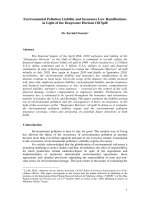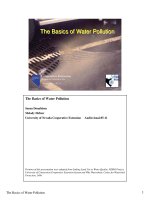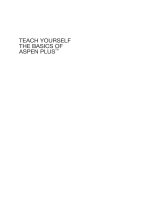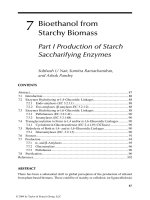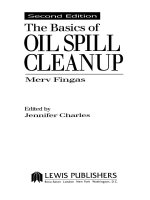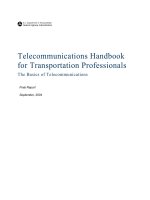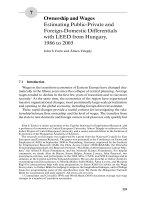The Basics of Oil Spill Cleanup - Chapter 7 potx
Bạn đang xem bản rút gọn của tài liệu. Xem và tải ngay bản đầy đủ của tài liệu tại đây (1.34 MB, 19 trang )
©2000 by CRC Press LLC
CHAPTER
7
Oil Recovery on Water
Recovery is the next step after containment in an oil spill cleanup operation. It
is often the major step in removing oil from the environment. As discussed in the
previous chapter, an important objective of containment is to concentrate oil into
thick layers to facilitate recovery. In fact, the containment and recovery phases of
an oil spill cleanup operation are often carried out at the same time. As soon as
booms are deployed at the site of a spill, equipment and personnel are mobilized to
take advantage of the increased oil thickness, favourable weather, and less weathered
oil. After oil spreads or becomes highly weathered, recovery becomes less viable
and is sometimes impossible.
This chapter covers three major approaches to the physical recovery of oil from
the water surface, namely skimmers, sorbents, and manual recovery. In many cases,
all of these approaches are used in a spill situation. Each method has limitations,
depending on the amount of oil spilled, sea and weather conditions, and the geo-
graphical location of the spill.
Alternative methods for treating oil directly on water are discussed in Chapters
9 and 10. The recovery of oil spilled on land is discussed in Chapter 12.
Skimmers
Skimmers are mechanical devices designed to remove oil from the water surface.
They vary greatly in size, application, and capacity, as well as in recovery efficiency.
Skimmers are classified according to the area where they are used, for example,
inshore, offshore, in shallow water, or in rivers, and by the viscosity of the oil they
are intended to recover, that is heavy or light oil.
Skimmers are available in a variety of forms, including independent units built
into a vessel or containment device and units that operate in either a stationary or
mobile (advancing) mode. Some skimmers have storage space for the recovered
oil and some of these also have other equipment such as separators to treat the
recovered oil.
©2000 by CRC Press LLC
The effectiveness of a skimmer is rated according to the amount of oil that it
recovers, as well as the amount of water picked up with the oil. Removing water
from the recovered oil can be as difficult as the initial recovery. Effectiveness depends
on a variety of factors including the type of oil spilled, the properties of the oil such
as viscosity, the thickness of the slick, sea conditions, wind speed, ambient temper-
ature, and the presence of ice or debris.
Most skimmers function best when the oil slick is relatively thick and most will
not function efficiently on thin slicks. The oil must therefore be collected in booms
before skimmers can be used effectively. The skimmer is placed in front of the boom
or wherever the oil is most concentrated in order to recover as much oil as possible.
Skimmers are often placed downwind from the boom, so that the wind will push
the oil toward them. Small skimmers are usually attached to light mooring lines so
that they can be moved around within the slick.
Weather conditions at a spill site have a major effect on the efficiency of skim-
mers. All skimmers work best in calm waters. Depending on the type of skimmer,
most will not work effectively in waves greater than 1 m or in currents exceeding
1 knot. Most skimmers do not operate effectively in waters with ice or debris such
as branches, seaweed, and floating waste. Some skimmers have screens around the
intake to prevent debris or ice from entering, conveyors or similar devices to remove
or deflect debris, and cutters to deal with seaweed. Very viscous oils, tar balls, or
oiled debris can clog the intake or entrance of skimmers and make it impossible to
pump oil from the skimmer’s recovery system.
Skimmers are also classified according to their basic operating principles: ole-
ophilic surface skimmers; weir skimmers; suction skimmers or vacuum devices;
Photo 59
A rope skimmer can be used to recover oil from under ice. (Al Allen)
©2000 by CRC Press LLC
elevating skimmers; submersion skimmers; and vortex or centrifugal skimmers. Each
type of skimmer has distinct advantages and disadvantages, which are discussed in
this section. Other miscellaneous devices used to recover oil are also discussed.
Oleophilic Surface Skimmers
Oleophilic surface skimmers
, sometimes called
sorbent surface skimmers
,
use a surface to which oil can adhere to remove the oil from the water surface. This
oleophilic surface can be in the form of a disc, drum, belt, brush, or rope, which is
moved through the oil on the top of the water. A wiper blade or pressure roller
removes the oil and deposits it into an onboard container or the oil is directly pumped
to storage facilities on a barge or on shore. The oleophilic surface itself can be steel,
aluminum, fabric, or plastics such as polypropylene and polyvinyl chloride.
Oleophilic skimmers pick up very little water compared to the amount of oil
recovered, which means they have a high oil-to-water recovery ratio. They therefore
operate efficiently on relatively thin oil slicks. They are not as susceptible to ice and
debris as the other types of skimmers. These skimmers are available in a range of
sizes and work best with light crude oils, although their suitability for different types
of oil varies with the design of the skimmer and the type of oleophilic surface used.
The operating principles of oleophilic skimmers are illustrated in Figure 21.
The
disc skimmer
is a common type of oleophilic surface device. The discs are
usually made of either polyvinyl chloride or steel. Disc skimmers work best with
light crude oil and are well suited to working in waves and among weeds or debris.
These skimmers are usually small and can be deployed by one or two people.
Photo 60
This oil was so heavy that an excavator was used to recover it from the boom. (Al Allen)
©2000 by CRC Press LLC
Disadvantages are that the recovery rate is slow and they work poorly with light
fuels or heavy oils.
The
drum skimmer
is another type of oleophilic surface skimmer. The drums
are made of either a proprietary polymer or steel. The drum skimmer works relatively
well with fuels and light crude, but is ineffective with heavy oils. Drum skimmers
are often smaller in size like the disc skimmer.
Belt skimmers
are constructed of a variety of oleophilic materials ranging from
fabric to conveyor belting. Most belt skimmers function by lifting oil up from the
water surface to a recovery well. As the motion of the belt through the water drives
oil away from the skimmer, however, oil must be forced to the belt manually or with
a water spray. Belt skimmers have been designed to overcome this problem, including
one that pumps the oily water through a porous belt and the
inverted belt skimmer
that carries the oil under the water. The oil is subsequently removed from the belt
by scrapers and rollers after the belt returns to a selected position at the bottom of
the skimmer. Belt skimmers of all types work best with heavier crudes and some
are specially constructed to recover tar balls and very heavy oils. Belt skimmers are
large and are usually built into a specialized cleanup vessel.
Brush skimmers
use tufts of plastic attached to drums or chains to recover the
oil from the water surface. The oil is usually removed from the brushes by wedge-
shaped scrapers. Brush skimmers are particularly useful for recovering heavier oils,
but are ineffective for fuels and light crudes. Some skimmers include a drum for
recovering light fuels and a brush for use with heavier oils. These skimmers can
Photo 61
This disc skimmer is being tested with a light crude oil. (Environment Canada)
©2000 by CRC Press LLC
also be used with limited amounts of debris or ice. Brush skimmers are available in
a variety of sizes, from small portable units to large units installed on specialized
vessels or barges.
Rope skimmers
remove oil from the water surface with an oleophilic rope of
polymer, usually polypropylene. Some skimmers have one or two long ropes that
are held in the slick by a floating, anchored pulley. Others use a series of small ropes
that hang down to the water surface from a suspended skimmer body. The rope
Figure 21
Oleophilic skimmers.
©2000 by CRC Press LLC
skimmer works best with medium viscosity oils and is particularly useful for recov-
ering oil from debris- and ice-laden waters. Rope skimmers vary in size from small
portable units to large units installed on specialized vessels or barges.
Weir Skimmers
Weir skimmers
are a major group of skimmers that use gravity to drain the oil
from the surface of the water into a submerged holding tank. The configurations of
weir skimmers are illustrated in Figure 22. In their simplest form, these devices
consist of a weir or dam, a holding tank, and a connection to an external or internal
pump to remove the oil. Many different models and sizes of weir skimmers are
available.
A major problem with weir skimmers is their tendency to rock back and forth
in choppy water, alternately sucking in air above the slick and water below. This
increases the amount of water and reduces the amount of oil recovered. Some models
include features for self-levelling and adjustable skimming depths so that the edge
of the weir is precisely at the oil-water interface, minimizing the amount of water
collected.
Weir skimmers do not work well in ice and debris or in rough waters and they
are not effective for very heavy oils or tar balls. Weir skimmers are economical,
Photo 62
This photo shows a drum skimmer built into a small boat. (Environment Canada)
©2000 by CRC Press LLC
however, and they can have large capacities. They are best used in calm, protected
waters. Weir skimmers have also been built into booms and have been moderately
successful in providing high recovery rates of lighter crudes.
Suction or Vacuum Skimmers
Suction or vacuum skimmers
use a vacuum or slight differential in pressure
to remove oil from the water surface. Often the “skimmer” is only a small floating
head connected to an external source of vacuum, such as a vacuum truck. The head
of the skimmer is simply an enlargement of the end of a suction hose and a float.
The principle of operation of a suction skimmer is shown in Figure 23.
Suction skimmers are similar to weir skimmers in that they sit on the water
surface, generally use an external vacuum pump system such as a vacuum truck,
and are adjusted to float at the oil-water interface. They also tend to be susceptible
to the same problems as weir skimmers. They are prone to clogging with debris that
can stop the oil flow and damage the pump. They also experience the problem of
rocking in choppy waters that causes massive water intake, followed by air intake.
Their use is restricted to light to medium oils.
Despite their disadvantages, suction skimmers are the most economical of all
skimmers. Their compactness and shallow draft make them particularly useful in
shallow water and in confined spaces. They operate best in calm water with thick
slicks and no debris. Very large vacuum pumps, called air conveyors, and suction
Photo 63
A rope skimmer is shown recovering a weathered crude oil. (Environment Canada)
©2000 by CRC Press LLC
dredges have been used to recover oil, sometimes directly without a head. Both these
adaptations, however, have the same limitations as smaller suction skimmers.
Photo 64
This brush skimmer is recovering a light lubricating oil. (Environment Canada)
Figure 22
Weir skimmer.
©2000 by CRC Press LLC
Elevating Skimmers
Elevating skimmers
or devices use conveyors to lift oil from the water surface
into a recovery area as illustrated in Figure 24. A paddle belt or wheel or a conveyor
belt with ridges is adjusted to the top of the water layer and oil is moved up the
recovery device on a plate or another moving belt. The operation is similar to
removing liquid from a floor with a squeegee. The oil is usually removed from the
conveyer by gravity. When operating these skimmers, it is difficult to maintain the
conveyor at the water line. In addition, they cannot operate in rough waters or in
waters with large pieces of debris, and cannot deal with light or very heavy oils.
Elevating skimmers work best with medium to somewhat heavy oils in calm waters.
They are generally large and are sometimes built into specialized vessels.
Submersion Skimmers
Submersion skimmers
use a belt or inclined plane to force the oil beneath the
surface as shown in Figure 25. The belt or plane forces the oil downward toward a
collection well where it is removed from the belt by a scraper or by gravity. The oil
then flows upward into the collection well, and is removed by a pump. Submersion
skimmers move faster than other skimmers and can therefore cover a large area,
making them suitable for use at larger spills. They are most effective with light oils
Photo 65
A weir skimmer is shown recovering heavy burn residue after the
Haven
incident.
(Oil Spill Response Limited)
©2000 by CRC Press LLC
with a low viscosity and when the slick is relatively thin. Disadvantages include a
poor tolerance to debris compared to other skimmers and they cannot be used in
shallow waters. Submersion skimmers are larger than other types of skimmers and
are usually mounted on a powered vessel.
Vortex or Centrifugal Skimmers
Vortex or centrifugal skimmers
use the difference in density between oil and
water to separate them and then selectively remove most of the oil. A water whirlpool
or vortex is created that draws the oil into a collection area where it is rotated in a
centrifuge, using either the force of the water itself or an external power source. The
oil is forced to the centre by the heavier water and pumped from the chamber. These
skimmers are not used often, however, because they are susceptible to debris. They
ˆ
Figure 23
Suction skimmers.
©2000 by CRC Press LLC
also take in a lot of water because varying amounts of oil entering the skimmer
make it difficult to regulate.
Other Devices
Many other devices are used to recover oil. Several skimmers combine some of
the principles of operation already discussed. For example, one skimmer uses an
inverted belt both as an oleophilic skimmer and a submersion skimmer. A fish trawl
has been modified by adding an oil outlet. Once the trawl is filled, however, usually
with water, it is almost impossible to maintain a dynamic balance in the trawl so
that further oil can enter. Regular fishing nets and fishing boats have been used to
recover extremely large tar balls, but the oil fouls the nets, making disposal or
expensive cleanup necessary. Garbage-collecting vessels have been successfully used
to remove oiled debris or tar balls.
Skimmer Performance
A skimmer’s performance is affected by a number of factors including the
thickness of the oil being recovered, the extent of weathering and emulsification of
the oil, the presence of debris, and weather conditions at the time of recovery
operations.
A skimmer’s overall performance is usually determined by a combination of its
recovery rate and the percentage of oil recovered. The recovery rate is the volume
of oil recovered under specific conditions. It is measured as volume per unit of time,
Photo 66
A suction skimmer is quite often affected by debris. (Environment Canada)
©2000 by CRC Press LLC
e.g., m
3
/h, and is usually given as a range. If a skimmer takes in a lot of water, it is
detrimental to the overall efficiency of an oil spill recovery operation. The results
of recent performance testing on various types of skimmers are given in Table 7.
In addition to these characteristics, other important measures of a skimmer’s
performance include the amount of emulsification caused by the skimmer, its ability
to deal with debris, ease of deployment, ruggedness, applicability to specific situa-
tions, and reliability.
Special-Purpose Ships
Special-purpose ships have been built specifically to deal with oil spills. Several
ships have been built with a hull that splits to form a V-shaped containment boom
with skimmers built into the hull, although this requires very expensive design features
Figure 24
Elevating skimmers.
©2000 by CRC Press LLC
so the ship can withstand severe weather conditions. Other ships have been built with
holes in the hull to hold skimmers, with sweeps mounted on the side to direct oil to
the skimmer area. Many small vessels have been custom-built to hold skimmers.
Sorbents
Sorbents are used for final cleanup of a spill or in very small spills. They can
be synthetic materials such as plastic, organic materials such as peat moss, or
inorganic materials such as clay. Sorbents come in many different forms, from loose
materials to pads or even booms.
Sorbents are materials that recover oil through either absorption or adsorption.
They play an important role in oil spill cleanup and are used in the following ways:
to clean up the final traces of oil spills on water or land; as a backup to other
containment means, such as sorbent booms; as a primary recovery means for very
small spills; and as a passive means of cleanup. An example of such passive cleanup
is when sorbent booms are anchored off lightly oiled shorelines to absorb any
remaining oil released from the shore and prevent further contamination or reoiling
of the shoreline.
Table 7 Performance of Typical Skimmers
Recovery Rate (m
3
/hr) for given oil type*
Skimmer Type Diesel
Light
Crude
Heavy
Crude
Bunker
C
Percent
Oil**
Oleophilic Skimmers
small disc 0.4 to 1 0.2 to 2 80 to 95
large disc 10 to 20 10 to 50 80 to 95
brush 0.2 to 0.8 0.5 to 20 0.5 to 2 0.5 to 2 80 to 95
large drum 10 to 30 80 to 95
small drum 0.5 to 5 0.5 to 5 80 to 95
large belt 1 to 5 1 to 20 3 to 20 3 to 10 75 to 95
inverted belt 10 to 30 85 to 95
rope 2 to 20 2 to 10
Weir Skimmers
small weir 0.2 to 10 0.5 to 5 2 to 20 20 to 80
large weir 30 to 100 5 to 10 3 to 5 50 to 90
advancing weir 1 to 10 5 to 30 5 to 25 30 to 70
Elevating Skimmers
paddle conveyer 1 to 10 1 to 20 1 to 5 10 to 40
Submersion Skimmers
large 0.5 to 1 1 to 80 1 to 20 70 to 95
Suction Skimmers
small 0.3 to 1 0.3 to 2 3 to 10
large trawl unit 2 to 40 20 to 90
large vacuum unit 3 to 20 3 to 10 10 to 80
Vortex/Centrifugal Skimmers
centrifugal unit 0.2 to 0.8 0.2 to 10 2 to 20
* Recovery rate depends very much on the thickness of the oil, type of oil, sea state,
and many other factors.
**This is the percentage of oil in the recovered product. The higher the value, the less
the amount of water and thus the better the skimmers’ performance.
©2000 by CRC Press LLC
Sorbents can be natural or synthetic materials. Natural sorbents are divided into
organic materials, such as peat moss or wood products, and inorganic materials,
such as vermiculite or clay. Sorbents are available in a loose form, which includes
granules, powder, chunks, and cubes, often contained in bags, nets, or “socks.”
Figure 25
Submersion skimmer.
Photo 67
An elevating skimmer recovers weathered crude oil. (Oil Spill Response Limited)
©2000 by CRC Press LLC
Sorbents are also available formed into pads, rolls, blankets, and pillows. Formed
sorbents are also made into sorbent booms and sweeps. One type of plastic sorbent
is formed into flat strips or “pom-poms,” which are particularly useful for recovering
very heavy oils.
The use of synthetic sorbents in oil spill recovery has increased in the last few
years. These sorbents are often used to wipe other oil spill recovery equipment, such
as skimmers and booms, after a spill cleanup operation. Sheets or rolls of sorbent
are often used for this purpose. Synthetic sorbents can often be re-used by squeezing
the oil out of them, although extracting small amounts of oil from sorbents is
sometimes more expensive than using new ones. Furthermore, oil-soaked sorbent is
difficult to handle and can result in minor releases of oil between the regeneration
area and the area where the sorbent is used.
The capacity of a sorbent depends on the amount of surface area to which the
oil can adhere as well as the type of surface. A fine porous sorbent with many small
capillaries has a large amount of surface area and is best for recovering light crude
oils or fuels. Sorbents with a coarse surface would be used for cleaning up a heavy
crude oil or Bunker. Pom-poms intended for recovering heavy Bunker or residual
oil consist of ribbons of plastic with no capillary structure. General purpose sorbents
are available that have both fine and coarse structure, but these are not as efficient
as products designed for specific oils.
Some sorbents are treated with oleophilic (oil-attracting) and hydrophobic
(water-repelling) agents to improve the ability of the material to preferentially absorb
oil rather than water. As natural sorbents often recover large amounts of water along
Photo 68
An elevating skimmer is readied for use beside a dock. (Environment Canada)
©2000 by CRC Press LLC
Photo 69
The excessive use of particulate sorbent complicates cleanup. (Environment
Canada)
Photo 70
This photo shows the cleanup of residual Bunker C using a pom-pom sorbent.
(Environment Canada)
©2000 by CRC Press LLC
with the oil, they can be treated to prevent water uptake. This type of treatment also
increases the ability of certain sorbents to remain afloat
.
The performance of sorbents is measured in terms of total oil recovery and water
pickup, similar to skimmers. “Oil recovery” is the weight of a particular oil recovered
compared to the original weight of the sorbent. For example, highly efficient syn-
thetic sorbent may recover up to 30 times its own weight in oil and an inorganic
sorbent may recover only twice its weight in oil. The amount of water picked up is
also important, with an ideal sorbent not recovering any water. Some results of
performance testing of typical sorbents with various types of oils are given in Table 8.
There are a number of precautions that must be considered when using sorbents.
Firstly, the excessive use of sorbents at a spill scene, especially in a granular or
particulate form, can compound cleanup problems and make it impossible to use
most mechanical skimmers. Sorbents may cause plugging in discharge lines or even
in the pumps themselves. Secondly, sorbents that sink should not be used as they
could be harmful to the environment. Sinking is a problem with many sorbents such
as untreated peat moss, all inorganic sorbents, and many wood products. Many
countries do not allow the use of sorbents that sink in applications on water as the
oil will usually be released from the sorbent over time and both the oil and the
Photo 71
Sorbent sheets are frequently used to clean up traces of oil spills. In this photo,
however, too many sheets have been used. (Environment Canada)
©2000 by CRC Press LLC
Photo 72
Manual recovery of oil and oil-soaked sorbent is a tedious process. (Environment
Canada)
Table 8 Performance of Some Sorbents
Typical Oil Recovery with Oil Type
(weight:weight)*
Sorbent Type Diesel
Light
Crude
Heavy
Crude
Bunker
C
Percent
Oil**
Synthetic Sorbents
polyester pads 7 9 12 20 90+
polyethylene pads 25 30 35 40 90+
polyolefin pom-poms 2 2 3 8 90+
polypropylene pads 6 8 10 13 90+
polypropylene pom-poms 3 6 6 15 90+
polyurethane pads 20 30 40 45 90+
Natural Organic Sorbents
bark or wood fibre 1 3 3 5 70
bird feathers 1 3 3 2 80+
collagen sponge 30 40 30 10 90+
peat moss 2 3 4 5 80+
treated peat moss 5 6 8 10 80+
straw 2 2 3 4 70
vegetable fibre 9 4 4 10 80+
Natural Inorganic Sorbents
clay (kitty litter) 3 3 3 2 70
treated perlite 8 8 8 9 70
treated vermiculite 3 3 4 8 70
vermiculite 2 2 3 5 70
* Recovery depends very much on the thickness of the oil, type of oil, surface type, and
many other factors.
**This is the percentage of oil in the recovered product. The higher the value, the lower
the amount of water and thus the better the sorbent’s performance.
©2000 by CRC Press LLC
sorbent are very harmful to benthic life. And finally, recovery and disposal of the
oiled sorbent material must be considered. As oiled sorbent is most often burned or
buried, the sorbent must retain the oil long enough so that it is not lost during
recovery operations or in transport to disposal sites.
Manual Recovery
Small oil spills or those in remote areas are sometimes recovered by hand.
Heavier oils are easier to remove this way than lighter oils. Spills on water close to
shorelines are sometimes cleaned up with shovels, rakes, or by cutting the oiled
vegetation. Hand bailers, which resemble a small bucket on the end of a handle, are
sometimes used to recover oil from the water surface. Manual recovery is tedious
and may involve dangers such as physical injury from falls on the shore. Most
shoreline cleanup is usually done manually, as discussed in Chapter 10.
